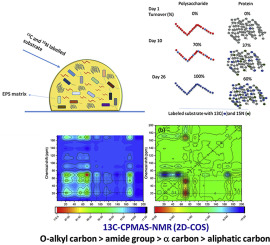当前位置:
X-MOL 学术
›
Water Res.
›
论文详情
Our official English website, www.x-mol.net, welcomes your
feedback! (Note: you will need to create a separate account there.)
Using stable isotope labeling approach and two dimensional correlation spectroscopy to explore the turnover cycles of different carbon structures in extracellular polymeric substances.
Water Research ( IF 11.4 ) Pub Date : 2019-11-30 , DOI: 10.1016/j.watres.2019.115355 Tahir Maqbool 1 , Jinwoo Cho 1 , Kyung Hoon Shin 2 , Jin Hur 1
Water Research ( IF 11.4 ) Pub Date : 2019-11-30 , DOI: 10.1016/j.watres.2019.115355 Tahir Maqbool 1 , Jinwoo Cho 1 , Kyung Hoon Shin 2 , Jin Hur 1
Affiliation

|
Extracellular polymeric substances (EPS) from activated sludge comprise many organic constituents with polysaccharides and proteins as the main components of two different functionalities. Despite a number of previous EPS studies, a fundamental question remained unanswered, namely, whether the different EPS components would have the same turnover cycle (i.e., formation/dissolution) in biological wastewater treatment systems. In this study, we employed a stable isotope labeling approach based on isotope-enriched substrates (i.e., 13C-glucose and 15NH4Cl) to examine the potential discrepancies in the turnover cycles among different major EPS constituents. Our results, based on substrate consumption in a batch bioreactor, evidenced the existence of differences in carbon and nitrogen cycles within bulk EPS with an earlier replenishment of organic carbon relative to organic nitrogen. The changes in the 13C nuclear magnetic resonance (13C NMR) spectra of EPS with operation clarified the relative differences in the turnover periods among several identified EPS structures with different chemical functionalities. Two-dimensional correlation spectroscopy (2D-COS) on the 13C NMR spectra further showed that the substrate-assimilated carbon functional groups appear to preferably formed within bulk EPS in the order of O-alkyl carbons > amides > α amino acids > aliphatic carbons. This study provides a novel insight into the dissimilar formation rates of different EPS structures after substrate assimilation. This isotope labeling approach can be further applied to determine the mass balance among the substrate, biomass, and bound/soluble EPS within activated sludge systems.
中文翻译:

使用稳定的同位素标记方法和二维相关光谱研究细胞外聚合物中不同碳结构的周转周期。
来自活性污泥的细胞外聚合物质(EPS)包含许多有机成分,其中多糖和蛋白质是两种不同功能的主要成分。尽管先前进行了许多EPS研究,但仍未回答一个基本问题,即在生物废水处理系统中,不同EPS组分是否具有相同的周转周期(即形成/溶解)。在这项研究中,我们基于富含同位素的底物(即13C-葡萄糖和15NH4Cl)采用了稳定的同位素标记方法,以检查不同主要EPS成分之间周转周期的潜在差异。根据批次生物反应器中底物的消耗,我们得出的结果是,有证据表明,相对于有机氮,较早补充有机碳后,散装EPS中存在碳和氮循环差异。EPS的13C核磁共振(13C NMR)谱随操作的变化阐明了几种已识别的具有不同化学功能的EPS结构之间周转期的相对差异。在13 C NMR光谱上的二维相关光谱(2D-COS)进一步显示,在大体积EPS内似乎优选以O-烷基碳>酰胺>α氨基酸>脂族碳的顺序形成了基质结合的碳官能团。这项研究为底物同化后不同EPS结构的不同形成速率提供了新颖的见解。
更新日期:2019-11-30
中文翻译:

使用稳定的同位素标记方法和二维相关光谱研究细胞外聚合物中不同碳结构的周转周期。
来自活性污泥的细胞外聚合物质(EPS)包含许多有机成分,其中多糖和蛋白质是两种不同功能的主要成分。尽管先前进行了许多EPS研究,但仍未回答一个基本问题,即在生物废水处理系统中,不同EPS组分是否具有相同的周转周期(即形成/溶解)。在这项研究中,我们基于富含同位素的底物(即13C-葡萄糖和15NH4Cl)采用了稳定的同位素标记方法,以检查不同主要EPS成分之间周转周期的潜在差异。根据批次生物反应器中底物的消耗,我们得出的结果是,有证据表明,相对于有机氮,较早补充有机碳后,散装EPS中存在碳和氮循环差异。EPS的13C核磁共振(13C NMR)谱随操作的变化阐明了几种已识别的具有不同化学功能的EPS结构之间周转期的相对差异。在13 C NMR光谱上的二维相关光谱(2D-COS)进一步显示,在大体积EPS内似乎优选以O-烷基碳>酰胺>α氨基酸>脂族碳的顺序形成了基质结合的碳官能团。这项研究为底物同化后不同EPS结构的不同形成速率提供了新颖的见解。

































 京公网安备 11010802027423号
京公网安备 11010802027423号